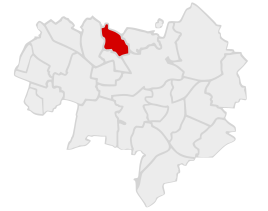Kleinwelka
|
Kleinwelka
Mały Wjelkow City of Bautzen
Coordinates: 51 ° 12 ′ 30 ″ N , 14 ° 23 ′ 30 ″ E
|
|
|---|---|
| Height : | 206 m |
| Area : | 1.37 km² |
| Residents : | 764 (Dec. 31, 2019) |
| Population density : | 558 inhabitants / km² |
| Incorporation : | January 1, 1999 |
| Postal code : | 02625 |
| Area code : | 035935 |
|
Location of Kleinwelka in Bautzen
|
|
Kleinwelka , in Upper Sorbian , has been part of the city of Bautzen in Saxony since January 1st, 1999 and was an independent municipality until then . The villages Großwelka , Lubachau and Kleinseidau originally also belonged to the district , but these have been counted as separate districts since 2007. The place belongs to the official Sorbian settlement area in Saxony.
history
The place was first mentioned in a document in 1345. The village chronicle goes back to the early 15th century.
In 1751, at the invitation of the Sorbian Matthäus Lange (Matej Dołhi), members of the Moravian Brethren settled in Kleinwelka. They founded the Kleinwelka colony , which they developed according to the architectural ideas of this free church . Since then, the center of the village has been the Herrnhuter Kirchsaal.
From 1778 the boarding school for children of missionaries (boys and girls' institution) played an important role . Over several years, numerous mission children came to school from Labrador, Suriname , Tanganyika and Natal to Kleinwelka and transferred to the Moravian Pedagogy in Niesky in higher classes .
After its liquidation in 1942 and conversion into a military hospital , a nursing home for the elderly is housed in the building of the boys' institution, which has belonged to the Moravian Diakonie since January 1, 2005. The boys' institution of the Moravian Brethren was an important location in the tradition of making the Moravian stars . Under the direction of Hermann Bourquin (1847–1913), the popular Advent stars were made here by children .
Kleinwelka was enlarged by the incorporation of Cölln and Milkwitz on January 1, 1973 and Salzenforst-Bolbritz (merger of these two places on July 1, 1969) on January 1, 1994. Schmochtitz was incorporated into Salzenforst on April 1, 1948. On October 1, 1998, the districts of Cölln, Großbrösern and Milkwitz were separated from Kleinwelka and reclassified to the municipality of Radibor .
In connection with the Battle of Bautzen , fighting broke out in Kleinwelka on May 20, 1813, in which French and Bavarian soldiers were killed. There is a memorial stone near the water tower in Kleinwelka.
For his statistics on the Sorbian population in Upper Lusatia, Arnošt Muka determined a total population of 605 in the colony and village of Kleinwelka in the 1880s; 196 of them were Sorbs (32%) and 409 Germans. In the actual village, however, the proportion of Sorbs was significantly higher at 91 percent. In 1956 Ernst Tschernik counted a Sorbian-speaking population of 31.1% in the community of Kleinwelka with districts.
Culture and sights
Kleinwelka is the Easter riding station from the center of Bautzen to Radibor. Several amusement parks have been created in the districts of Kleinwelka and Großwelka .
- Kleinwelka Dinosaur Park and Dinosaur Garden
- Kleinwelka maze
The maze was created in 1992 on the private initiative of the Frenzel family based on a plan by Manfred Frenzel. The rectangular complex of over 5000 m² is divided into three areas: a hedge maze , an adventure labyrinth with various climbing devices and a puzzle labyrinth in which there are thirteen fields with different categories of questions. The planting consists of 3800 evergreen trees of life . The shortest route to the destination measures 356 meters, the longest 1053 meters. There are 30,720 ways to reach the goal of the maze without having to pass a section twice.
- Kleinwelka Miniature Park
The miniature park was opened in 1998. The 60 hectare facility with over 600 figures in 90 scenes was created by Tom Glöß. He himself most of the wooden figures stilted . Many of the scenes show rural life in Upper Lusatia . Part of the park is the so-called Klein-Ossi-Land , in which scenes from everyday life in the GDR are depicted. Three objects in the miniature park were included in the Guinness Book of Records : the smallest Sorbian Easter egg and the smallest and largest smoker in the world.
- Kleinwelka Colony
The Kleinwelka colony is a settlement of the Moravian Brethren . It was built in the 1750s in a small Wendish settlement around a manor. 32 listed buildings and the “Gottesacker” cemetery belong to the ensemble, which has largely been preserved in its original state.
economy
The production facility for Bautz'ner mustard , which is known throughout Germany, is located in Kleinwelka .
traffic
Kleinwelka is on the regional bus routes of the Oberlausitz regional bus from Bautzen to Hoyerswerda. Since November 2015 run long distance buses from MeinFernbus once a day between Bautzen and Berlin with a stop in Kleinwelka, if necessary.
Personalities
- Johann August Miertsching ( Jan Awgust Měrćink ; 1817–1875), Sorbian missionary and interpreter
- Walter Bau (1888–1967), teacher, geologist, paleontologist and zoologist
literature
- Kleinwelka . In: August Schumann : Complete State, Post and Newspaper Lexicon of Saxony. 4th volume. Schumann, Zwickau 1817, p. 679.
- Kleinwelka . In: August Schumann : Complete State, Post and Newspaper Lexicon of Saxony. 17th volume. Schumann, Zwickau 1830, p. 383.
- Cornelius Gurlitt : Kleinwelka. In: Descriptive representation of the older architectural and art monuments of the Kingdom of Saxony. 31. Booklet: Bautzen Official Authority (Part I) . CC Meinhold, Dresden 1908, p. 116.
Individual evidence
- ↑ StBA: Changes in the municipalities in Germany, see 1999
- ↑ Municipalities 1994 and their changes since January 1, 1948 in the new federal states , Metzler-Poeschel publishing house, Stuttgart, 1995, ISBN 3-8246-0321-7 , publisher: Federal Statistical Office
- ^ StBA: Changes in the municipalities in Germany, see 1998
- ↑ Ernst Tschernik: The development of the Sorbian population . Akademie-Verlag, Berlin 1954, p. 55 .
- ^ Ludwig Elle: Language policy in the Lausitz . Domowina-Verlag, Bautzen 1995, p. 245 .
Web links
- Kleinwelka in the Digital Historical Directory of Saxony
- Kleinwelka Colony in the Digital Historical Directory of Saxony
- Kleinwelka maze







